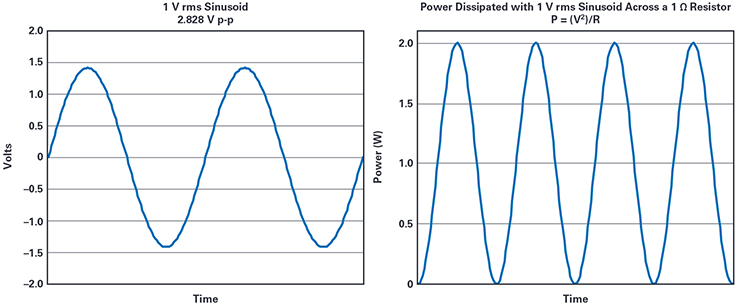
© Analog Devices Inc.
Application Notes |
RMS Power vs. Average Power
Question: Should I use units of root mean square (rms) power to specify or describe the ac power associated with my signal, system, or device?
Answer: It depends on how you define rms power.
You do not want to calculate the rms value of the ac power waveform. This produces a result that is not physically meaningful.
You do use the rms values of voltage and/or current to calculate average power, which does produce meaningful results.
Discussion
How much power is dissipated when a 1 V rms sinusoidal voltage is placed across a 1 Ω resistor?
 This is well understood1 and there is no controversy here.
Now, let’s see how this compares with the value from an rms power calculation. Figure 1 shows a graph of a 1 V rms sinusoid. The peak-to-peak value is 1 V rms × 2 √2 = 2.828 V, swinging from +1.414 V to –1.414 V.2
This is well understood1 and there is no controversy here.
Now, let’s see how this compares with the value from an rms power calculation. Figure 1 shows a graph of a 1 V rms sinusoid. The peak-to-peak value is 1 V rms × 2 √2 = 2.828 V, swinging from +1.414 V to –1.414 V.2
 Figure 1. Graph of a 1 V rms sinusoid. / Figure 2. Graph of the power dissipated by a 1 V rms sinusoid across a 1 Ω resistor.
Figure 2 is a graph of the power dissipated by this 1 V rms sinusoid across a 1 Ω resistor (P = V2/R) that shows:
Figure 1. Graph of a 1 V rms sinusoid. / Figure 2. Graph of the power dissipated by a 1 V rms sinusoid across a 1 Ω resistor.
Figure 2 is a graph of the power dissipated by this 1 V rms sinusoid across a 1 Ω resistor (P = V2/R) that shows:
 This can be verified by using a more detailed formula4 in MATLAB® or Excel.
This can be verified by using a more detailed formula4 in MATLAB® or Excel.

About the Author: Doug Ito is an applications engineer for the High Speed ADC team at © Analog Devices, Inc., San Diego, California. He earned a bachelor’s degree in electrical engineering from San Diego State University. Doug is a member of ADI’s EngineerZone® High Speed ADC Support Community. He can be reached at douglas.ito@analog.com.
 This is well understood1 and there is no controversy here.
Now, let’s see how this compares with the value from an rms power calculation. Figure 1 shows a graph of a 1 V rms sinusoid. The peak-to-peak value is 1 V rms × 2 √2 = 2.828 V, swinging from +1.414 V to –1.414 V.2
This is well understood1 and there is no controversy here.
Now, let’s see how this compares with the value from an rms power calculation. Figure 1 shows a graph of a 1 V rms sinusoid. The peak-to-peak value is 1 V rms × 2 √2 = 2.828 V, swinging from +1.414 V to –1.414 V.2
 Figure 1. Graph of a 1 V rms sinusoid. / Figure 2. Graph of the power dissipated by a 1 V rms sinusoid across a 1 Ω resistor.
Figure 2 is a graph of the power dissipated by this 1 V rms sinusoid across a 1 Ω resistor (P = V2/R) that shows:
Figure 1. Graph of a 1 V rms sinusoid. / Figure 2. Graph of the power dissipated by a 1 V rms sinusoid across a 1 Ω resistor.
Figure 2 is a graph of the power dissipated by this 1 V rms sinusoid across a 1 Ω resistor (P = V2/R) that shows:
- The instantaneous power curve has an offset of 1 W and swings from 0 W to 2 W.
- The rms value of this power waveform is 1.225 W.
 This can be verified by using a more detailed formula4 in MATLAB® or Excel.
This can be verified by using a more detailed formula4 in MATLAB® or Excel.
- The average value of this power waveform is 1 W. This is obvious from inspection; the waveform swings symmetrically above and below 1 V. The same value results from calculating the numerical average of the waveform datapoints.
- The average power value matches the power calculated using rms voltage.
- Power dissipated from voltage across a resistor is a fundamental relation that is easily derived from Ohm’s law (V = IR) and the fundamental definitions of voltage (energy/unit of charge) and current (unit of charge/time). Voltage × current = energy/time = power
- The peak-to-peak amplitude of a sinusoid is the rms value multiplied by 2√2. For a sinusoidal voltage, V p-p = V rms × 2√2, where V p-p is the peak-to-peak voltage and V rms is the rms voltage. This is a well-known relation that is documented in countless text books, as well as here: en.wikipedia.org/wiki/Root_mean_square.
- This is adapted from the rms value calculated from a constant dc offset value plus a separate rms ac value and in the application note “Make Better AC RMS Measurements with Your Digital Multimeter” by Keysight.
- The standard textbook definition is one example of a more detailed formula.

About the Author: Doug Ito is an applications engineer for the High Speed ADC team at © Analog Devices, Inc., San Diego, California. He earned a bachelor’s degree in electrical engineering from San Diego State University. Doug is a member of ADI’s EngineerZone® High Speed ADC Support Community. He can be reached at douglas.ito@analog.com.

